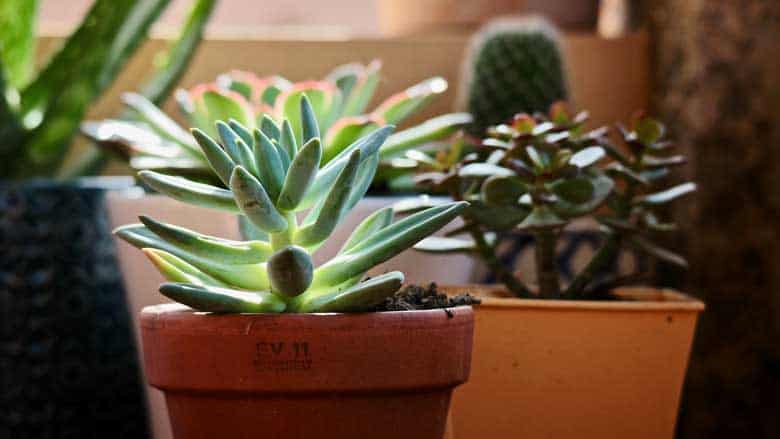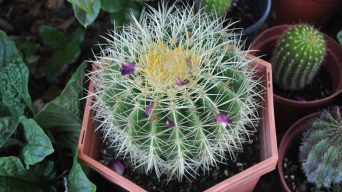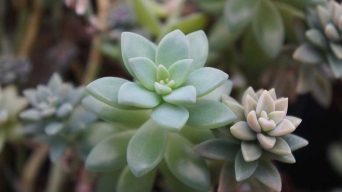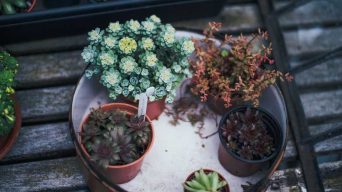Succulents are one of the easiest plants to care for. They’re also quite popular, which is why you might have a few in your garden.
Succulents grow slowly on their own, but decreasing the growth rate, even more can help you keep your succulents small.
So, if you want to keep them small and prevent them from growing out of control, follow these tips.
7 Tips for Keeping Succulents Small
Are you interested in how to keep succulents small? So, to keep your succulents small, there are some tips that can help.
Follow these succulent tips to keep your plants small and healthy:
1. Keep the Succulent In a Sunny Spot
Keep succulents in a sunny spot. They need sunlight and will grow if they are not getting enough light.
Succulents need six hours of sunlight per day to stay healthy and prevent them from getting too big. The sun’s rays will help them produce the energy they need to stay small.
When succulents are too big, they may have trouble taking in enough sunlight to survive.
Place it on an east or west-facing window ledge if possible. If this isn’t doable for you, then put it near a south-facing window where there’s lots of natural light between noon and mid-afternoon when the sun is at its brightest.
2. Remove Any Leaves That Grow off at an Angle
The leaves that grow off at an angle will turn into new shoots and cause the succulent plant to take up more space.
Succulents can grow new sprouts, so if you want them to stay small, remove any leaves growing off at an angle.
Simply pull off these leaves to keep the succulent small.
It is also important to remove any leaves that look different from the rest. These are often stressed or diseased and should be removed for your succulents’ health.
3. Prune Your Succulents Regularly To Prevent the Spread of Overgrowth
Pruning succulents helps make them smaller. The goal is to minimize the size of a hefty plant that’s likely been neglected for some time.
Trim your succulent’s leaves to make it smaller by cutting off all of its leaves on each side until only about an inch is left. Then tie up the stem with wire and trim any excess stem, so just the top survives.
Trimming also cuts down how many times per day this plant needs to be watered. This can be helpful during droughts or hot spells when plants are at risk of getting overwatered and dying.
4. Cut Off the Top Of the Succulent
Beheading your succulents is an easy way to keep them small.
Simply cut off the top of a tall plant and remove any leaves that are in its path. This will encourage new growth from the bottom, which makes it bushy instead of tall.
You can also pinch off any of the leaves that are at a higher point on the plant. This will result in a more compact shape for your succulent.
However, it’s important to note that this method is not ideal for all succulents, and some require special care when it comes to trimming their stems.
Be sure you know what type of succulent you have before deciding how best to cut it back or remove its leaves.
5. Reduce the Root Space
A way to keep succulents small is by reducing the root space.
Doing this will stunt growth, which means your plant won’t grow out of its pot as quickly because it can’t get enough room. A small pot can be used to limit how much space the plant has to grow.
The key is knowing how big your succulent will get in its current environment before you buy it. If possible try to purchase one with the same size as what you have planned so it doesn’t outgrow the pot right away.
The potting mix should be packed tightly around the plant. This will ensure that there is no space for roots to grow into and they’ll stay contained in a small area, meaning this won’t take up too much of your pot.
You can also limit the roots space by adding a layer of terracotta or gravel and potting your succulent in it. This will prevent roots from stretching out into all different directions, which causes them to grow big quickly.
Find one that is at least half an inch thicker than the diameter of your plant’s container for good support on top of the soil.
Add layers, so if you want to add more plants later, you can add them without disturbing what already exists below. A couple of inches deep should suffice as long as there are spaces between each layer for air circulation and good drainage purposes.
6. Cut Back on Watering and Fertilizing
Cut back on watering and fertilizing so you don’t overstimulate new growth or cause them to become leggy (lacking in foliage).
Use a heavy dose of slow-release fertilizer once or twice during the growing season (spring and summer). Just make sure not to fertilize again until next spring when new growth begins.
This will help keep plants smaller because they won’t want to put on more height if there is no root energy reserve stored up.
In addition, by reducing watering, you’ll also find that it’s easier to keep succulents small, and they’ll be more drought tolerant.
7. Pick Your Succulent Carefully
You can easily control how big your succulent will grow by picking the right one from the start. Pick succulents that are small, grow slowly, and don’t get too big.
The best options of small succulents include:
Haworthia (Zebra Plant)
Haworthia is one of the most popular succulents. This is because they can be grown into a variety of sizes.
The smaller varieties, like the Zebra Cactus (Haworthia tessellata), only grow to about two inches tall and wide with time.
Zebra Cacti do not require much water or soil for them to thrive in their environment. However, they need lots of light each day so that their leaves develop more chlorophyll which gives them those striking stripes.
Sempervivum (Hens and Chicks)
The Sempervivum are a group of plants that grow easily. These plants have two types: the rosette and the hen-and-chick plant.
The rosettes grow to be about an inch in diameter, while the chicks can get up to three inches wide with time.
Sempervivums prefer dry conditions, so it is essential that you don’t water them too often or allow their soil to become soaked. However, they do need sunlight, just like all succulents.
Lithops
The Lithops are a species of plant that has two different looks: the pebble and the living stone. This plants come in various colors, but they all share one characteristic: their small size!
Lithops prefers to be watered about once every three weeks or so. However, you don’t want them sitting in water for too long if at all possible.
Make sure not to over-water these succulents as well. Otherwise, they won’t last very long before they start wilting away from lack of water.
Air Plants (Tillandsia sp.)
Air plants are small and delicate, but they can be the perfect addition to your succulent collection.
Air plants do not need soil in order to grow; instead, you should plant them right against a surface that already has moss or other greenery. Then make sure to mist their leaves with water once every two days, so they don’t shrivel up too much.
Echeveria Minima
These small plants can grow up to three inches tall and live in just about any type of environment with proper care.
However, Echeveria minima plants still need plenty of sunlight, so make sure you keep that in mind when planting succulents indoors or outdoors.
It would help if you also watered your Echeverias once every week or two, depending on how dry it has been lately. Otherwise, they may start dying off from lack of water.
Sedum (Little Missy)
This mini succulent is known for its small size and rock-hard leaves. It will grow up to about an inch in height, which is perfect if you want a tiny plant to sit on the windowsill or desk at work.
The Sedum can also be grown outside during the warmer months of the year (spring through fall). They don’t care how cold it gets as long as they have plenty of sunlight.
However, make sure not to overwater them when it’s raining out since damp roots will quickly rot this little guy.
Final Thoughts
You can grow a succulent garden in a variety of ways.
The key is to use the right type and the proper care for your needs, which will promote growth and make them more enjoyable.
Remember that it isn’t always about how big they look, what’s important is how healthy they are.







